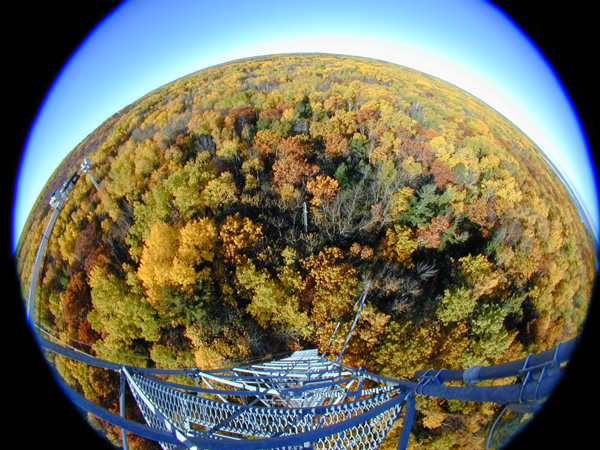Developing an Australian phenology monitoring network using near-surface remote sensing

by Trevor Keenan (Macquarie University) and Tim Brown (Australian National University)
Workshop report: TERN ACEAS phenocam workshop, 11-14 March 2014, North Stradbroke Island, Queensland.
Plant phenology is highly sensitive to climate, thus serving as an excellent indicator of the potential impacts of climate change. Phenological changes not only affect plant function, but have multiple cascading effects throughout ecosystems. This makes the accurate monitoring of phenology key to understanding the response of Australian vegetation to a changing climate.

‘Classic phenology’: a mixed forest in autumn colours as seen from a flux tower in the USA. But what does phenology look like in Australia? (image credit: Chris Vogel)
So how do we effectively monitor phenology? Satellite remote sensing offers valuable information on large-scale phenology, but is hampered by either coarse spatial or temporal resolution, and interference from cloud cover. Ground observations offer the most direct assessment of phenological status, but are prohibitively manually intensive. Luckily, recent advances in near-surface remote sensing technologies promise to resolve the issues related to ground observations and satellite data, and bridge the gap between the two.
Digital repeat photography is becoming widely used for near surface remote sensing of vegetation (Sonnentag et al., 2011). Canopy greenness, which has been used extensively for phenological applications, can be readily quantified from camera images, providing a wealth of information regarding vegetation state and function (Keenan et al., 2014). The application of this ‘Phenocam’ technology is emerging worldwide, and is being coupled with advances in drone technology. Through leveraging the TERN network, and the multitude of newly established OzFlux sites, Australia is in an excellent position to become a world leader in the field.

Workshop participants
This workshop focused on harnessing the potential of PhenoCams in Australia by bringing together leading experts in the field of near-surface remote sensing of vegetation from across Australia, China and the US. The broad objectives of the meeting were to assess the utility of digital repeat photography for monitoring Australian vegetation, and to outline standard operating procedures for the design of an automated Australian network using such methods.
We collected data from 9 existing PhenoCam sites around Australia. These sites represent a broad range of vegetation types, from semi-arid grasslands, to Savannahs, to tropical forests. In order to facilitate the analysis of the existing imagery, we developed a new R-package (‘Phenora’), and concurrently applied a Matlab package developed by researchers in the US. Where available, we also collected eddy-covariance data on carbon and water fluxes, along with the associated meteorological observations.
Our analysis and discussions highlight several results of importance, both with regard to data management and analysis, and the effective design of an automated network for phenological monitoring.
The synthesis of our collated datasets revealed the diversity of seasonal dynamics in Australian vegetation, both within and between ecosystems. Grassland ecosystems exhibited a temporal dynamic highly affected by water availability and grazing. By merging concurrent meteorological data with PhenoCam derived greenness indices, we hope to improve models of the response of grassland ecosystems to water stress. Similarly, savannah ecosystems varied within and between years, with different responses of trees vs grass dynamics to wet/dry cycles. Such observations should prove invaluable for improving our understanding of ecohydrological strategies. For tropical forests, a complex interplay between individual trees and whole ecosystem dynamics was observed. Although observations of the tropical forests canopy were relatively constant at the ecosystem scale, this was the result of strong seasonal dynamics of individual trees, which cancelled out when aggregated to the ecosystem scale. This suggests different species-specific strategies for coping with changes in environmental conditions, which could be used to improve our understanding of species competitive interactions and niche theory.
The process of data collation also highlighted several issues with regard to data transfer and standardization, as well as the associated metadata. The importance of standardized instrument deployment was evidenced by recurrent shifts in the field of view of the cameras, frequent data gaps, image quality issues, and data corruption. The lack of standardized guidelines was highlighted as a key issue needing resolution. We therefore drafted a white paper providing guidance for the deployment of PhenoCams in Australia, which outlines a roadmap for the development of the Australian PhenoCam network.
How will this affect Australian ecosystem science & management?
The development of an Australian phenology monitoring network goes far beyond the monitoring of phenology. Australian ecosystems demonstrate complex canopy dynamics both within and between years, in response to the large variability in the Australian climate. An Australian PhenoCam network promises the ability to monitor temporal canopy dynamics in an automated, distributed, and (most importantly!) cost-effective manner. The resulting data should greatly improve our understanding of how Australian ecosystems respond to changes in Australian climate, help us build better models, and ultimately improve our ability to project how Australian ecosystems are likely to change in the coming century. In the face of climate change, such information is vital to inform policy decisions and management strategies alike.
References
Keenan, T. F., O. Sonnentag, M. Friedl, K. Hufkens, J. William Munger, M. Toomey, and A. D. Richardson (2014) Tracking forest phenology and seasonal physiology using digital repeat photography: a critical assessment. Ecological Applications, http://dx.doi.org/10.1890/13-0652.1.
Sonnentag, O., K. Hufkens, C. TesheraSterne, A. M. Young, M. Friedl, B. H. Braswell, T. Milliman, J. O’Keefe, and A.D. Richardson (2012) Digital repeat photography for phenological research in forest ecosystems. Agricultural and Forest Meteorology 152: 159-177.
